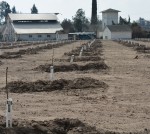
When Vance Kennedy called the soil north and west of Modesto “a national treasure,” he was speaking from the perspective of an award-winning scientist who has studied soil and water all his life. Kennedy is also a small-scale farmer—he farms eight acres of citrus on the famous “sandy loam” soil north of Modesto.
Realtors and developers like to cite figures that show farm acreage is increasing, and they’re right if all you consider is irrigated dirt. On the east side of Stanislaus County alone, tens of thousands of acres have been planted in almonds just in the last few years. However, no one who really knows farmland expects those orchards to produce for even one full twenty-five year cycle—they’re dependent on a rapidly vanishing aquifer and most are planted just above a subsurface of fractured rock.
Good soil—the kind farmers call “prime farmland”—is rare. Of California’s 100 million total acres, only about 5,274,000 are considered prime farmland. According to David Carle, that’s land, “with sustainable high yields and long-term agricultural productivity.”
Unfortunately, sustainability isn’t mentioned much when we talk about land, water, and the growth of cities, but it should be.
If only five percent of the land in the entire state is capable of sustainable long-term food production, we should be taking a lot better care of it. But according to a study by California State University, Stanislaus, we’re not only not taking care of it, we’re paving it over.
In the five short years between 1997 and 2002, California lost 8,282 farms and over a million acres of farmland. From 1998 through 2000, the San Joaquin Valley led the entire state in conversion of irrigated farmland to urban use. The total acreage lost included 5,610 acres of prime farmland.
Even worse, from 1992 to 1997, we lost 85,200 acres of prime farmland statewide, much of it right here in the San Joaquin Valley. In fact, conversion of prime farmland is occurring thirty percent faster than conversion of non-prime farmland.
In the San Joaquin Valley, the conversion is producing cities like Stockton, which is bankrupt, and Modesto, which can’t afford enough police officers to provide public safety. It’s producing a region known as the “National Capitol of Meth,” and the “Appalachia of the West.”
Even though sprawl has long been determined to be cost inefficient, most San Joaquin Valley cites still seem intent on spreading outward instead of upward. A classic case is the “Gateway Village” project in Madera County. The 2,000 acre development will replace vineyards and citrus orchards and will get water from a convoluted arrangement that involves billionaire “farmer” Stewart Resnick.
Here in Stanislaus County, farmers and city dwellers alike are fighting a proposal to include Wood Colony, which features some of our best farmland, in Modesto’s general plan. The rational solution to rampant consumption of prime farmland is urban boundaries, but even supporters of farmland preservation go mum when the subject comes up.
Yolo, Sonoma, and Ventura Counties have had urban boundaries long enough to assess the effects, and all three have found that boundaries do indeed promote farmland preservation. In Sonoma County, a bitter debate of twenty years ago has turned into widespread acceptance of urban limits.
Here in Stanislaus County, despite vocal and even vehement support for farmland preservation, political leaders shy away from limits and boundaries, maybe because they’re too beholden to the local Chamber of Commerce to dare propose a rational solution to our ongoing loss of prime farmland.

Eric,
The City Council will never support urban limits that actually saves prime farmland. That will have to come from a citizen created proposition. Newman is creating their own ” urban limits ” in respsonse to LAFCO. They area covers its entire general plan area and assumes an unrealistic growth rate. So what they have really created are urban limit lines for show, for the most part. By the time they reach the lines, it will time to redraw the lines outward again. Nothing changes.
Other counties have urban limits that work well. The key is getting the word out and getting smart growth people in office.